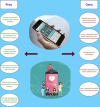The Role of Mobile Health Technology in Perioperative Spinal Care: A Systematic Scoping Review and Narrative Synthesis
- PMID: 38496189
- PMCID: PMC10944329
- DOI: 10.7759/cureus.54254
The Role of Mobile Health Technology in Perioperative Spinal Care: A Systematic Scoping Review and Narrative Synthesis
Abstract
Smartphone applications play a crucial role in contemporary healthcare by aiming to enhance patient care through technology. Mobile health (mHealth) applications have proven to have transformative potential in enhancing patients' outcomes in candidates undergoing orthopedic and spinal surgery. In the context of the pervasive use of smartphones and the exponential growth of mHealth apps, totaling over 99,000 in 2021, the applications had a significant impact on lifestyle management, supporting initiatives like smoking cessation with motivational reminders and progress tracking. Patient compliance is significantly enhanced, reducing surgery cancellations and improving outcomes through effective adherence to pre-operative treatments and instructions. Physiotherapy receives a substantial boost as mHealth facilitates video-guided exercises, potentially improving compliance and treatment outcomes. Data collection takes on innovative dimensions, with mHealth apps capturing post-operative metrics like physical activity, offering valuable insights into patient recovery trends. Remote care is streamlined through features like photo uploads and direct messaging, proving especially beneficial in times of crises such as the COVID-19 pandemic. Despite these merits, challenges emerge, including issues related to technological literacy, potential discrimination due to paywalls, and concerns about patient data confidentiality. Overcoming these challenges requires standardized approaches, legislative measures, and ongoing research to refine and optimize mHealth applications for diverse healthcare settings.
Keywords: mobile technology; ortho surgery; spinal column; spine injury; spine rehab.
Copyright © 2024, Hayat et al.
Conflict of interest statement
The authors have declared that no competing interests exist.
Figures
References
-
- Medical applications for pharmacists using mobile devices. Aungst TD. Ann Pharmacother. 2013;47:1088–1095. - PubMed
-
- 25 ways to use your smartphone. Physicians share their favorite uses and apps. Kiser K. https://pubmed.ncbi.nlm.nih.gov/21560878/ Minn Med. 2011;94:22–29. - PubMed
Publication types
LinkOut - more resources
Full Text Sources


